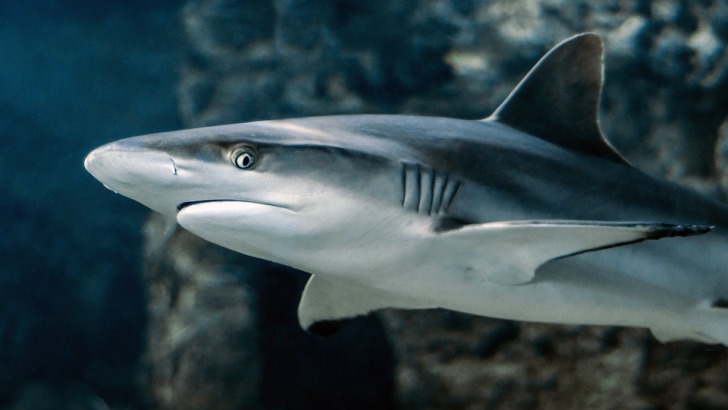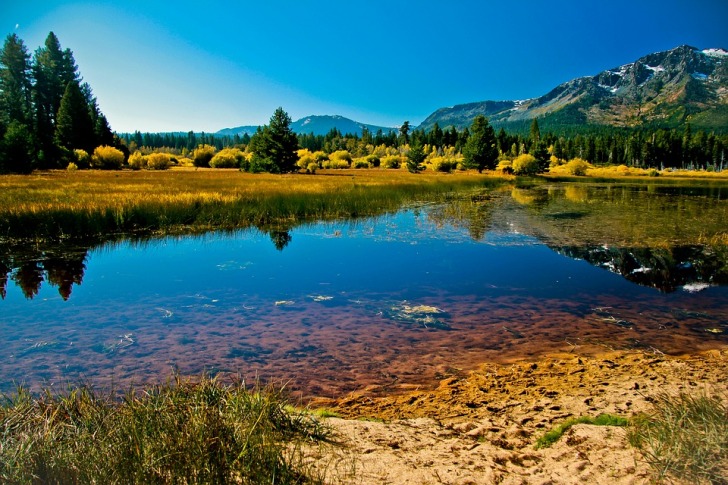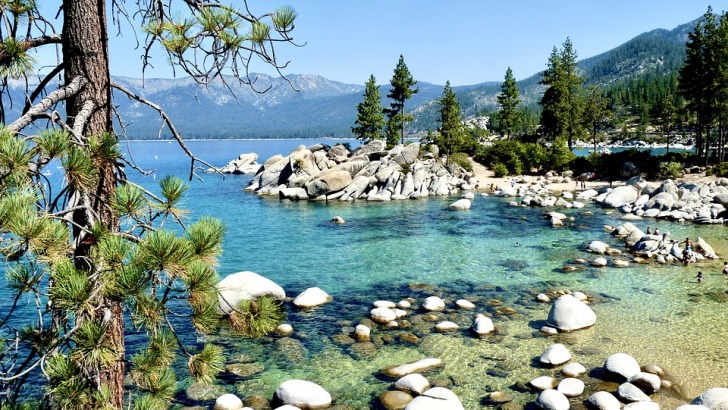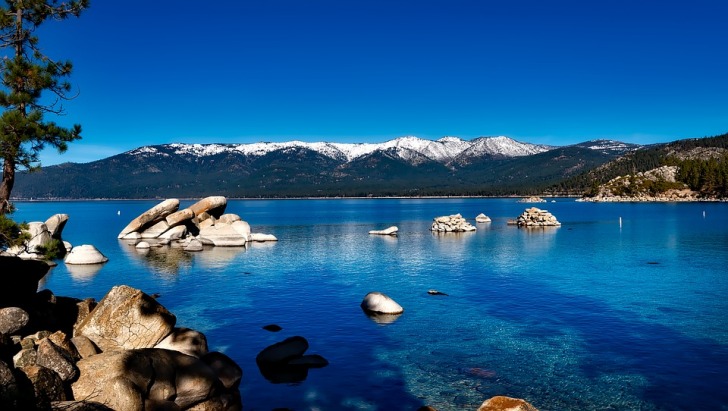Lake Tahoe is a freshwater lake.
It straddles the border between Nevada and California.
Its clear-blue pure and fresh waters create a boater and angler’s haven and a summer fun spot for singles and families.
Lake Tahoe is recognized to be the largest alpine lake (defined by a lake situated above the tree line) in North America and the second deepest lake in the United States (Lake Tahoe’s surface is at an altitude of 6,229 feet or 1.15 miles above sea level).
The lake covers more than 122,000 acres.
In terms of volume, only the five lakes that define the Great Lakes are larger.
Lake Tahoe attracts year-round tourism, with gorgeous scenery, summer recreational activities, and some of the best skiing in North America.
More than 15 million people visit Lake Tahoe for its stunning beauty, outdoor adventures, and laid-back lifestyle.
Surrounding peaks in Lake Tahoe reach upwards of 11,000 feet.
Lake Tahoe hit mainstream popularity when it hosted the 1960 Winter Olympics.
Lake Tahoe is now home to nearly two dozen ski areas offering excellent skiing conditions across 700 downhill runs and almost 500 miles of cross-country trails.
On the Nevada side of Lake Tahoe, there is legalized gambling and lakeside casinos and resorts.
The type of shark found in Lake Tahoe may likely be in one of the casinos.

Contents
So… Are There Sharks in Lake Tahoe?
No.
Sharks are, for the most part, seawater animals, except for a few species of freshwater sharks across the globe like the Bull Shark, which prefers coastal waters.
Sharks, unless they are one of the few varieties that have adapted to lower saline conditions and cold water, need the buoyancy created by saltwater and therefore are primarily found in saltwater locations.
Venturing outside of saltwater creates a dangerous and often deadly chemical reaction with regard to the shark’s ability to retain salt.
Sharks must maintain a certain salt level, because any dilution to their internal levels leads to the rupturing of cells, bloating, sinking, and death.
Note though sharks tolerate brackish water as well (a mix of salt and freshwater), which has higher saline concentrations than freshwater but less saline than other more hospitable marine environments.
Sharks may find their way to freshwater, but can only tolerate it for short stints, perhaps, foraging for food for a few hundred miles, except for a few with unique adaptive shark qualities and behavior in the more hostile environment.
But, with regard to Lake Tahoe, how could a shark find its way to a lake situated 6,000+ above sea level, miles from any coastline?
Lake Tahoe is home to amazing varieties of freshwater fish – Rainbow, Lake, and Lahontan trout, plus Bluegill, Smallmouth and Largemouth Bass, Brown Bullhead, plus many other species of fish.
However, no one has caught or even clearly taken a photograph of a shark that came from Lake Tahoe’s crystal blue waters.
With a measured depth of 1,645 feet, there are very few photos of the bottom of the Lake.
To give this some perspective, the Empire State Building is 1,454 feet tall.
This harsh, extreme depth will likely need professional equipment and specialists to truly discover what lives at the bottom of Lake Tahoe.
It is unlikely that a shark will be discovered in Lake Tahoe, but one never knows because stranger things have happened.
To date, there have been no official sightings of sharks in Lake Tahoe, although legends persist. (See below – Interesting Facts About Lake Tahoe.)

Is it Safe to Swim in Lake Tahoe?
For those who know, there is no place as magical as a summer adventure in Lake Tahoe.
But water and swimming safety require everyone to pay close attention to other swimmers and swimming/weather conditions.
The first rule of safety in Lake Tahoe would be to wear a life jacket, especially if you are unsure of the water’s depth and your own ability and strength as a swimmer.
But note, even in summer, the water just below the warm surface can be pretty cold.
The high altitude of Lake Tahoe, along with the frigid water temperatures, creates a different type of swimming condition and one that requires caution.
Temperatures near the surface may drop as low as 40 degrees in winter.
To give this perspective, the average water temperatures in Iceland during the summer are approximately 52 degrees Fahrenheit.
Swimmers should be cautious of this due to Cold Water Shock – a condition that is caused by dangerously cold water (Below 59 degrees Fahrenheit) that may impact a swimmer’s ability to breathe and move.
Cold Water Shock may also impact a swimmer’s heart rhythms and blood pressure – created by the frigid temperatures.
In addition, Lake Tahoe tends to have inconsistent weather patterns (and fast-moving storms) that may pose a threat for any swimmer.
As such, it is important to make plans accordingly but take the time to review Lake Tahoe’s meteorological conditions – by the University of California @ Davis (UC Davis page) to be prepared.
An average of seven people die in Lake Tahoe’s waters each year.
Most Lake Tahoe emergencies and drownings happen in minutes – sometimes, maybe even seconds.
Drowning is often silent without warning and may go unnoticed – unlike portrayals on TV.
To ensure safety, choose to swim with a buddy for this reason.
With that in mind, if you maintain a cautious approach and strictly follow safety guidelines, Lake Tahoe is a great place for a swim.

Interesting Shark Facts in Lake Tahoe
With an impressive depth of 1,644 feet, the reality is that no one knows for sure what lies at the bottom depths of the lake.
And while Lake Tahoe is well-known for its crystal blue water, clarity at its deepest depths still contains mysteries yet to be discovered.
Shark rumors surfaced in 2016, when a photographer from Northern California – trying to capture the lower landscape of Lake Tahoe, took a blurry photograph (with a waterproofed GoPro Camera) of what looked like a shark – and thus the legend began.
Most specialists agree that the blurry photograph in question was likely an extremely large Lake Trout that happened to be captured by the camera and not a shark.
And note, with water that runs that deep, a fish as large as the one captured on film could have called the depths of Lake Tahoe home for a very long time.
Most sharks can only live in saltwater, although several varieties have been adapted to meet the different conditions (buoyance and saline) provided by freshwater.
Sharks are categorized based on the temperature of the water’s surface in the areas in which they inhabit.
- Tropical Sharks prefer warm water, like the Great Hammerhead with an amazing 360-degree vision capability. Tropical Sharks tend to prefer the warm waters found in and around the equator.
- Polar Sharks live in waters near or at the polar ice caps, in frigid temperatures that hover just above freezing. An example of a polar shark includes the Dogfish Shark.
- Temperate Sharks can inhabit both and migrate when needed, if only temporarily. Larger varieties of temperate sharks, like the Great White Shark, may find their way to tropical waters.
In addition, there are a few types of freshwater sharks in the world.
Consider these examples:
- Speartooth Shark – although quite rare, the Speartooth Shark is native to Northern Australia and Papua New Guinea. This shark has about 29 rows of teeth on the upper and lower jaws.
- Ganges Shark – native to rivers in India, the Ganges Shark, is considered endangered.
- Bull Shark – have a strong ability to swim and are often found in freshwater lakes connected to rivers. Bull Sharks are deadly and swim shallow waters near swimmers.
- Borneo River Shark – considered among the rarest of freshwater sharks in the world. Borneo River Sharks are small, typically no more than 2 feet in length.
3 Safety Tips for Swimming in Shark-infested Waters
Shark attacks are much rarer than most people think.
In 2020, there were only 129 cases reported globally.
When planning on a swim in the water in which you may encounter a shark, it is best to follow safety guidelines:
- It is best to avoid the shark’s favorite feeding time – generally at dawn or dusk as that may attract the attention of the shark. Also, avoid splashing, which a shark may mistake as a fear response of its prey species.
- A shark’s keen eyesight is attracted to shiny objects, such as jewelry or sunglasses. The sun’s reflecting on shiny jewelry worn in the water may actually look similar to the scales of a fish – from the shark’s perspective.
- A shark has an amazing sense of smell for blood. Sharks can smell blood from a position hundreds of miles away. As such, it is important to avoid swimming with an open wound that is actively bleeding.
Summary
Lake Tahoe is an amazing and stunning location in the Sierra Nevada.
Before the Olympics brought fame to this tiny town, Lake Tahoe was home to Frank Sinatra, Dean Martin, and Howard Hughes, among others.
Lake Tahoe attracts year-round tourists with its gorgeous scenery, summer recreation activities, and some of the best skiing in North America.
More than 15 million people visit Lake Tahoe for its stunning beauty, outdoor adventures, and a laid-back lifestyle
Summer in Lake Tahoe can be special and exciting.
But safety in the water requires everyone to follow safety standards like paying close attention to other swimmers and swimming/weather conditions.
Sources
- https://www.tahoesbest.com/tahoe_facts.htm
- https://www.tripsavvy.com/lake-tahoe-casinos-1478012
- https://www.nationalgeographic.com/animals/article/shark-attack-threats-bull-sharks-location
- https://californiacrossings.com/fun-facts-about-lake-tahoe/
- https://aceboater.com/en/cold-water-shock-symptoms-treatment
- https://tahoe.ucdavis.edu/climate-change
- https://www.kcra.com/article/what-s-swimming-in-lake-tahoe-s-depths/6430355
- https://www.blueplanetaquarium.com/blog/sharks/where-do-sharks-live/
- https://theaquariumguide.com/articles/freshwater-sharks-real-sharks
- https://nt.gov.au/__data/assets/pdf_file/0009/206388/speartooth-shark.pdf
- https://india.mongabay.com/2020/06/the-rare-shark-of-the-ganga/
- https://www.nationalgeographic.com/animals/fish/facts/bull-shark
- https://animals.fandom.com/wiki/Borneo_River_Shark
- https://www.floridamuseum.ufl.edu/shark-attacks/yearly-worldwide-summary/
- https://www.iucn.org/
- https://www.wwf.org.uk/learn/fascinating-facts/sharks
- https://www.cnn.com/2020/01/22/us/florida-shark-attack-capital-trnd/index.html
- https://www.siyachts.com/where-most-shark-attacks-occur
Frequently Asked Questions
How many shark species are in the world?
According to the International Union for Conservation of Nature (IUCN), there are more than 500 species of sharks, of which about 28% are under threat of extinction.
How long have sharks been on Earth?
Sharks have inhabited the Earth’s waters for more than 400 million years – arriving even before the dinosaur age.
What state has the greatest number of shark bites each year?
The United States accounts for more than half of the world’s shark bites, with Florida accounting for more than half of the shark-bites in the United States and earning the name – the Shark Capital of the World.
Of the five United States counties with the most shark-bites ever recorded, four are in Florida and one in Maui, Hawaii












Lake Tahoe is a stunning and popular destination with clear blue waters and a variety of recreational activities, but there is no evidence of sharks living in the freshwater lake and it is generally safe for swimming.